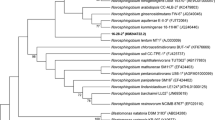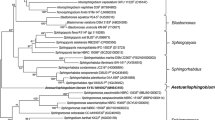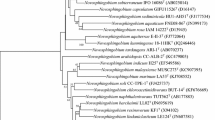Abstract
A novel Gram-stain negative, yellow coloured, strictly aerobic, rod-shaped, non-motile bacterium designated as THW-SA1T, was isolated from lake water near Samsung apartment, Suwon, Republic of Korea. The phylogenetic analysis based on 16S rRNA gene sequences showed that strain THW-SA1T belongs to the genus Novosphingobium and is closely related to Novosphingobium taihuense (97.8 %) and Novosphingobium subterraneum (97.1 %). The DNA–DNA relatedness values between strain THW-SA1T and the most closely related type strains were found to be less than 30.0 %. The DNA G+C content was determined to be 67.5 mol%. The strain grows optimally at 25–28 °C, at pH 7.0, and in the presence of 0.5 % NaCl. The predominant isoprenoid quinone was identified as ubiquinone Q-10. The polar lipid profile comprises diphosphatidylglycerol, phosphatidylglycerol, phosphatidylethanolamine, phosphatidyldimethylethanolamine, sphingoglycolipid, phosphatidylcholine, some unidentified phospholipids and some unidentified polar lipids. Fatty acids characteristic for this genus, such as C16:1, C14:0 2-OH, C16:1 ω6c and/or C16:1 ω7c (summed feature 3) and C18:1 ω6c and/or C18:1 ω7c (summed feature 8) were also detected. On the basis of the phenotypic and genotypic analysis, the strain THW-SA1T is considered to represent a novel species of the genus Novosphingobium, for which the name Novosphingobium aquaticum sp. nov. is proposed. The type strain is THW-SA1T (=KCTC 42608T=CCTCC AB 2015114T).

Similar content being viewed by others
References
Balkwill DL, Drake GR, Reeves RH, Frederickson JK, White DC, Ringelberg DB, Chandler DP, Romine MF, Kennedy DW, Spadoni CM (1997) Taxonomic study of aromatic-degrading bacteria from deep-terrestrial-subsurface sediments and description of Sphingomonas aromaticivorans sp. nov., Sphingomonas subterranea sp. nov., and Sphingomonas stygia sp. nov. Int J Syst Bacteriol 47:191–201
Bernardet JF, Nakagawa Y, Holmes B, Subcommittee on the taxonomy of Flavobacterium and Cytophaga-like bacteria of the International Committee on Systematics of Prokaryotes (2002) Proposed minimal standards for describing new taxa of the family Flavobacteriaceae and emended description of the family. Int J Syst Evol Microbiol 52:1049–1070
Chen N, Yu XJ, Yang JS, Wang ET, Li BZ, Yuan HL (2015) Novosphingobium tardum sp. nov., isolated from sediment of a freshwater lake. Antonie van Leeuwenhoek 108:51–57
Collins MD, Jones D (1981) Distribution of isoprenoid quinone structural types in bacteria and their taxonomic implications. Microbiol Rev 45:316–354
Dai Y, Li N, Zhao Q, Xie S (2015) Bioremediation using Novosphingobium strain DY4 for 2,4-dichlorophenoxyacetic acid-contaminated soil and impact on microbial community structure. Biodegradation 26:161–170
Ezaki T, Hashimoto Y, Yabuuchi E (1989) Fluorometric deoxyribonucleic acid-deoxyribonucleic acid hybridization in microdilution wells as an alternative to membrane filter hybridization in which radioisotopes are used to determine genetic relatedness among bacterial strains. Int J Syst Bacteriol 39:224–229
Fautz E, Reichenbach H (1980) A simple test for flexirubin-type pigments. FEMS Microbiol Ecol 8:87–91
Felsenstein J (1981) Evolutionary trees from DNA sequences: a maximum likelihood approach. J Mol Evol 17:368–376
Felsenstein J (1985) Confidence limits on phylogenies: an approach using the bootstrap. Evolution 39:783–791
Fitch WM (1971) Toward defining the course of evolution: minimum change for a specific tree topology. Syst Zool 20:406–416
Fujii K, Kikuchi S, Satomi M, Ushio-Sata N, Morita N (2003) Novosphingobium tardaugens sp. nov., an oestradiol-degrading bacterium isolated from activated sludge of a sewage treatment plant in Tokyo. Int J Syst Evol Microbiol 53:47–52
Gao S, Zhang Y, Jiang N, Luo L, Li QX, Li J (2015) Novosphingobium fluoreni sp. nov., isolated from rice seeds. Int J Syst Evol Microbiol. doi:10.1099/ijs.0.000111
Gillis M, De Ley J, De Cleene M (1970) The determination of molecular weight of bacterial genome DNA from renaturation rates. Eur J Biochem 12:143–153
Glaeser SP, Kämpfer P, Busse HJ, Langer S, Glaeser J (2009) Novosphingobium acidiphilum sp. nov., an acidophilic salt-sensitive bacterium isolated from the humic acid-rich Lake Grosse Fuchskuhle. Int J Syst Evol Microbiol 59:323–330
Glaeser SP, Bolte K, Busse HJ, Kämpfer P, Grossart HP, Glaeser J (2013a) Novosphingobium aquaticum sp. nov., isolated from the humic-matter-rich bog Lake Grosse Fuchskuhle. Int J Syst Evol Microbiol 63:2630–2636
Glaeser SP, Bolte K, Martin K, Busse HJ, Grossart HP, Kämpfer P, Glaeser J (2013b) Novosphingobium fuchskuhlense sp. nov., isolated from the north-east basin of Lake Grosse Fuchskuhle. Int J Syst Evol Microbiol 63:586–592
Hall TA (1999) BioEdit: a user-friendly biological sequence alignment editor and analysis program for Windows 95/98/NT. Nucleic Acids Symp Ser 41:95–98
Hiraishi A, Ueda Y, Ishihara J, Mori T (1996) Comparative lipoquinone analysis of influent sewage and activated sludge by high-performance liquid chromatography and photodiode array detection. J Gen Appl Microbiol 42:457–469
Huo YY, You H, Li ZY, Wang CS, Xu XW (2015) Novosphingobium marinum sp. nov., isolated from seawater. Int J Syst Evol Microbiol 65:676–680
Kämpfer P, Young CC, Bussee HJ, Lin SY, Rekha PD, Arun AB, Chen WM, Shen FT, Wu YH (2011) Novosphingobium soli sp. nov., isolated from soil. Int J Syst Evol Microbiol 61:259–263
Kämpfer P, Martin K, McInroy JA, Glaeser SP (2015a) Proposal of Novosphingobium rhizosphaerae sp. nov., isolated from the rhizosphere. McInroy JA, Glaeser SP (2015) Novosphingobium gossypii sp. nov., isolated from Gossypium hirsutum. Int J Syst Evol Microbiol 65:195–200
Kämpfer P, Martin K, McInroy JA, Glaeser SP (2015b) Novosphingobium gossypii sp. nov., isolated from Gossypium hirsutum. Int J Syst Evol Microbiol. doi:10.1099/ijs.0.000339
Kim OS, Cho YJ, Lee K, Yoon SH, Kim M, Na H, Park SC, Jeon YS, Lee JH, Yi H, Won S, Chun J (2012) Introducing EzTaxon-e: a prokaryotic 16S rRNA Gene sequence database with phylotypes that represent uncultured species. Int J Syst Evol Microbiol 62:716–721
Kimura M (1983) The neutral theory of molecular evolution. Cambridge University Press, Cambridge
Lane DJ (1991) 16S/23S rRNA sequencing. In: Stackebrandt E, Goodfellow M (eds) Nucleic Acid Techniques in Bacterial Systematics. Wiley, Chichester, pp 115–176
Li YQ, Li L, Chen W, Duan YQ, Nimaichand S, Guo JW, Gao R, Li WJ (2015) Novosphingobium endophyticum sp. nov. isolated from roots of Glycyrrhiza uralensis. Arch Microbiol 8(3):2928–2936
Lin SY, Hameed A, Liu YC, Hsu YH, Lai WA, Huang HI, Young CC (2014) Novosphingobium arabidopsis sp. nov., a DDT-resistant bacterium isolated from the rhizosphere of Arabidopsis thaliana. Int J Syst Evol Microbiol 64:594–598
Liu ZP, Wang BJ, Liu YH, Liu SJ (2005) Novosphingobium taihuense sp. nov., a novel aromatic-compound-degrading bacterium isolated from Taihu Lake, China. Int J Syst Evol Microbiol 55:1229–1232
Maruyama T, Park HD, Ozawa K, Tanaka Y, Sumino T, Hamana K, Kato K (2006) Sphingosinicella microcystinivorans gen. nov., sp. nov., a microcystin-degrading bacterium. Int J Syst Evol Microbiol 56:85–89
McConaughy BL, Laird CD, McCarthy BJ (1969) Nucleic acid reassociation in formamide. Biochemistry 8:3289–3295
Mesbah M, Premachandran U, Whitman WB (1989) Precise measurement of the G+C content of deoxyribonucleic acid by high performance liquid chromatography. Int J Syst Bacteriol 39:159–167
Minnikin DE, ODonnell AG, Goodfellow M, Alderson G, Athalye M, Schaal A, Parlett JH (1984) An integrated procedure for the extraction of bacterial isoprenoid quinones and polar lipids. J Microbiol Methods 2:233–241
Moore DD, Dowhan D (1995) Preparation and analysis of DNA. In: Ausubel FW, Brent R, Kingston RE, Moore DD, Seidman JG, Smith JA, Struhl K (eds) Current protocols in molecular biology. Wiley, New York, pp 2–11
Neef A, Witzenberger R, Kämpfer P (1999) Detection of Sphingomonads and in situ identification in activated sludge using 16S rRNA-targeted oligonucleotide probes. J Ind Microbiol Biotechnol 23:261–267
Niharika N, Moskalinova H, Kaur J, Sedlackova M, Hampla A, Damborsky J, Prokop Z, Lal R (2013) Novosphingobium barchaimii sp. nov., isolated from hexachlorocyclohexane-contaminated soil. Int J Syst Evol Microbiol 63:667–672
Saitou N, Nei M (1987) The neighbor-joining method: a new method for reconstructing phylogenetic trees. Mol Biol Evol 4:406–425
Sasser M (1990) Identification of bacteria by gas chromatography of cellular fatty acids, MIDI Technical Note 101. DE: MIDI Inc, Newark
Sohn JH, Kwon KK, Kang JH, Jung HB, Kim SJ (2004) Novosphingobium pentaromativorans sp. nov., a high-molecular-mass polycyclic aromatic hydrocarbon degrading bacterium isolated from estuarine sediment. Int J Syst Evol Microbiol 54:1483–1487
Stabili L, Gravili C, Tredici SM, Piraino S, Talà A, Boero F, Alifano P (2008) Epibiotic Vibrio luminous bacteria isolated from some hydrozoa and bryozoa species. Microb Ecol 56:625–636
Suzuki S, Hiraishi A (2007) Novosphingobium naphthalenivorans sp. nov., a naphthalene-degrading bacterium isolated from polychlorinated-dioxin-contaminated environments. J Gen Appl Microbiol 53:221–228
Takeuchi M, Hamana K, Hiraishi A (2001) Proposal of the genus Sphingomonas sensu stricto and three new genera, Sphingobium, Novosphingobium and Sphingopyxis, on the basis of phylogenetic and chemotaxonomic analyses. Int J Syst Evol Microbiol 51:1405–1417
Tamaoka J, Katayama-Fujiruma A, Kuraishi H (1983) Analysis of bacterial menaquinone mixtures by high performance liquid chromatography. J Appl Bacieriol 54:31–36
Tamura K, Stecher G, Peterson D, Filipski A, Kumar S (2013) MEGA6: molecular evolutionary genetics analysis version 6.0. Mol Biol Evol 30:2725–2729
Thompson JD, Gibson TJ, Plewniak F, Jeanmougin F, Higgins DG (1997) The CLUSTAL_X windows interface: flexible strategies for multiple sequence alignment aided by quality analysis tools. Nucleic Acids Res 25:4876–4882
Tiirola MA, Männistö MK, Puhakka JA, Kulomaa MS (2002) Isolation and characterization of Novosphingobium sp. strain MT1, a dominant polychlorophenol-degrading strain in a groundwater bioremediation system. Appl Environ Microbiol 68:173–180
Tiirola MA, Busse HJ, Kämpfer P, Männistö MK (2005) Novosphingobium lentum sp. nov., a psychrotolerant bacterium from a polychlorophenol bioremediation process. Int J Syst Evol Microbiol 55:583–588
Wayne LG, Brenner DJ, Colwell RR, 9 other authors (1987) International Committee on Systematic Bacteriology. Report of the ad hoc committee on reconciliation of approaches to bacterial systematics. Int J Syst Bacteriol 37:463–464
Weisburg WG, Barns SM, Pelletier DA, Lane DJ (1991) 16S ribosomal DNA amplification for phylogenetic study. J Bacteriol 173:697–703
Yabuuchi E, Yano I, Oyaizu H, Hashimoto Y, Ezaki T, Yamamoto H (1990) Proposals of Sphingomonas paucimobilis gen. nov. and comb. nov., Sphingomonas parapaucimobilis sp. nov., Sphingomonas yanoikuyae sp. nov., Sphingomonas adhaesiva sp. nov., Sphingomonas capsulata comb. nov., and two genospecies of the genus Sphingomonas. Microbiol Immunol 34:99–119
Yuan J, Lai Q, Zheng T, Shao Z (2009) Novosphingobium indicum sp. nov., a polycyclic aromatic hydrocarbon-degrading bacterium isolated from a deep-sea environment. Int J Sys. Evol Microbiol 59:2084–2088
Acknowledgments
This work was conducted under the industrial infrastructure program (No. N0000888) for fundamental technologies which is funded by the Ministry of Trade, Industry & Energy (MOTIE, Korea).
Author information
Authors and Affiliations
Corresponding author
Additional information
The NCBI GenBank accession number for the 16S rRNA gene sequence of strains THW-SA1T is KP410550.
Electronic supplementary material
Below is the link to the electronic supplementary material.
Fig. S1
Transmission electron micrographs of strain THW-SA1T. After negative staining with uranyl acetate. Bar indicated 200 nm (PDF 59 kb)
Fig. S2
The maximum likelihood tree based on 16S rRNA gene sequence analysis showing phylogenetic relationships between strain THW-SA1T and members of the genus Novosphingobium. Bootstrap values less than 60 % were not indicated. Sphingomonas jaspsi TDMA-16T was used as an out group. Scale bar, 0.02 substitutions per nucleotide position (PDF 191 kb)
Fig. S3
Two-dimensional TLC of the total polar lipids of strain THW-SA1T (a) and Novosphingobium taihuense KACC 18096T (b), stained for total polar lipids with 5 % ethanolic molybdatophosphoric acid. Abbreviations: DPG, diphosphatidylglycerol; PG, phosphatidylglycerol; PE, phosphatidylethanolamine; PDE, phosphatidyldimethylethanolamine, SGL sphingoglycolipid, PC, phosphatidylcholine; PL1-3, unidentified phospholipids; L1-4, unidentified polarlipids (PDF 16 kb)
Rights and permissions
About this article
Cite this article
Singh, H., Du, J., Yang, JE. et al. Novosphingobium aquaticum sp. nov., isolated from lake water in Suwon, Republic of Korea. Antonie van Leeuwenhoek 108, 851–858 (2015). https://doi.org/10.1007/s10482-015-0539-7
Received:
Accepted:
Published:
Issue Date:
DOI: https://doi.org/10.1007/s10482-015-0539-7




